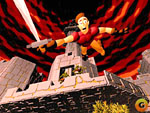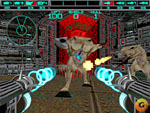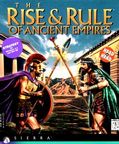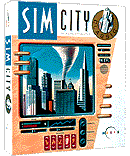
Technology and Education
Education and Simulation/Gaming and
Computers
by Jerry Seay
Robert Scott
Small Library
An Educator's Encounter
On my way home from the College of Charleston I had wandered into the local mall video arcade, attracted no doubt by the whirring beeps, flashing lights, the throbbing of competing, repeating musical themes, and by the fact that I am fascinated by games. In this particular instance I was attracted by a video cabinet that featured two brightly colored dinosaurs duking it out "Bruce Lee style" while tiny humans in caveman outfits scrambled underfoot trying to avoid becoming dino toe jam. The name of this gaming wonder was Primal Rage! and it was quite interesting to observe the demo screen sorting through a series of different dinosaur combatants with different backgrounds and weather phenomenon (the battle on ice was particularly exciting).
As I was enjoying this primal slugfest, a small boy of about 8 years of age, stepped abruptly in front of me, obscured my view of the screen, said, "excuse me, sir," and gripped the control knobs.
Feeling as if I was suddenly the intruder, I muttered, "sure," and stepped back while the kid dropped two quarters into the machine, chose a dino avatar from a selection of gruesome beasts on the screen and proceeded to beat the stuffing out of another dinosaur.
The kid was a master. His hands jerked knobs and pushed buttons on that game panel faster than a good typest on a key board. He was deep into it too as evidenced by his moans and unabashed shouts of "oooooo" and "ahhhh" and "way cool" every few seconds. Every now and then, without taking his eyes from the screen, he would shout, "hey, Mom, come watch this!"
Of course I'm sure his mom, who was nowhere in sight, would have just been proud to see her little darling's virtual Jurassic beast bashing the stew out of everything in site. But, the boy was clearly enjoying himself. In fact he was enthralled.
Watching the excitement and pure joy emanating from this child, of course, could bring only one thought to my educator's mind: "Boy, I sure wish I could get my Library 101 class only half this excited about what I was teaching them."
Of course, I then could hear my students saying back, "yea, if you could make it half as exciting as this, we would be."
To which I would, wittily reply, "yea, if I had a machine like that thing that could help me teach Library 101, it would be exciting." Of course, dinosaurs would not necessarily be involved. (Though I certainly would not rule them out.)
But, hey, we actually do have such tools. And we have had them for a long time. They have not always been in the form of computers, and some still are not. They are the oldest form of experiential learning and have been used in education, business, and training. They are called simulations, simulation games, educational games, or for want of a better term, just "games."
 Games and Media
Games and Media
When one thinks of computer games, the mind usually reels to images of exploding targets, flashy graphics, sometimes violent mayhem, pulsing repetitive music and sound effects, In short, everything that makes preschoolers to teenagers (and many times adults) spend long hours losing themselves in an exciting, mesmerizing, pleasurable virtual world. The thought of using such a game as an educational tool, however, is enough to make some educators go ga-ga. Indeed, many teachers balk at the very thought of taking up valuable class time playing a "game." But, is using a computer game, or any game, as a learning tool so implausible?
The learning style of the average student these days is vastly different than students of the past by virtue of the environment and the culture in which they have been raised. J.C. Herz writes in Joystick Nation:
If your memories have pop soundtracks or big-screen kisses, if you've ever told an anecdote with instant replays or a coda of stadium applause, it's because you've been brought up with media that furnish those conventions. Videogames provide a new set of conventions, which are being rapidly assimilated, as you read this, by a legion of six-year-olds. Their mental grammar is going to reflect that, just as the baby boomers' worldview echoes the impact of television. But whereas TV turned kids of the fifties and sixties into a nation of screen watchers, videogames have created a cadre of screen manipulators ( p.1-2).
The word edutainment, that nefarious combination of entertainment with education, has already become a cliché. The MTV generation of students these days, so goes the prevailing, wisdom, can not just learn. They must be entertained while they learn. If they are not entertained while they learn, then you’ve lost them. John F. Affisco of Hofstra University said as much in an article in Simulation and Gaming. "It is already apparent that contemporary students have limited attention spans, have a more visual learning style than their predecessors, and need to be entertained in the classroom (Affisco, 1994, p.171)."
Perhaps it is not so much that students need to be entertained as much as it is that their culture has conditioned them to interact - interface (if you will allow a computer term)- in a certain way with information. Students are not necessarily lazier than their predecessors of yore; they have been raised in a completely different environment that seems to call for a new way of learning: a more interactive learning style. It is no wonder then that Affisco continues, "Simulation and gaming offers our best chance of reaching these students (p. 171)."
A recent article in American Scientist notes that IQ scores internationally are rising (Neisser, 1997). One theory is that our increased exposure to visually rich mass media---television, computers, video games -- has enabled us to perform better on spatial-visual tests. The theory states that the ability to interpret different forms of information from different media and make some kind of sense of it is what these IQ tests actually test for. The human population has been subjected to an increasingly fast and changing type and amount of media information over the past 50 years. This change in their media environment, so goes the claim, has actually trained human beings to do better on IQ tests. Increasingly, technology, then, is not just changing what we think and know, but it is affecting how we think and come to know. Types of education that utilize simulation and gaming approaches could, therefore, be more effective now than they have been at any other time in history.
Simulations and Games
The use of games and simulations in education is well
documented in history and in the recent literature. They have
been used in preschool, K-12, the university, the military,
business, and by older adults (Dempsey et al., 1997). 
But, what exactly do we mean when we say simulation and gaming? First, though computers have certainly allowed the evolution of simulation gaming a quatum leap forward, they are by no means the first use of simulation gaming nor are they the only type of simulation gaming done today. Historically, the word games has been used to connote a pastime of a trivial, if fun, endeavor. It is this connotation that today seems to cause some educators to flinch when they hear the word games and imagine frivolous time wasted play that serves only to entertain and certainly not educate to any significant degree. D.R. Cruickshank, a researcher in this area, defines them this way:
Simulations are the products that result when one creates the appearance or effect of something else. Games are contests in which both players and opponents operate under rules to gain a specified objective. A further distinction can be made between academic and non-academic games (such as table tennis or checkers) that are primarily for fun. Academic games, such as anagrams or war games, are primarily for or based upon learning (Cruickshank, 1980, p. 75 ).
Cruickshank further distinguished between two types of academic games.
There are two types of academic games: simulation games and non-simulation games. Non-simulation games are those in which a player solves problems in a school subject such as spelling or mathematics by making use of principles of that subject or discipline. The other type of academic game is the simulation game in which participants are provided with a simulated environment in which to play. These games are intended to provide students with insight into the process or event from the real world which is being simulated (p. 76).
It is the use of simulation games which holds the most promise as a truly dynamic educational tool.
A Little Bit of Sim-Game History
Though simulation gaming has been used for a long time,
notably by the 19th century Prussians in their war games prior to
their successful stomping of France in the Franco-Prussian war,
it was the 1960’s and 1970’s that saw the heyday of
educational simulations and games. It was in the social sciences
that simulation and gaming first took root and took off. In 1974
Richard D. Duke, a guru of the early days of education
simulation-gaming, saw gaming as a developing, and in many
instances superior, form of understanding: a new language. He
wrote, "As the true character of gaming as a unique  communication form becomes clear, its
use as a Future's Language will become pervasive (Duke,
1974, p. xi). Gaming, then, was thought of as a new
language with which to educate. It was the new way to
educate. Simulations and games were developed that taught social
systems, communication, politics, ecology, health, history,
relationships, marketing, business, language skills, economics,
geography, and mathematics. Games were used to help make
decisions on marriage, career exploration, hiring decisions, or
deciding admission into college (Ifill, 1994). Some even thought
that gaming would eventually replace the lecture as the main way
of teaching (Dukes, 1994).
communication form becomes clear, its
use as a Future's Language will become pervasive (Duke,
1974, p. xi). Gaming, then, was thought of as a new
language with which to educate. It was the new way to
educate. Simulations and games were developed that taught social
systems, communication, politics, ecology, health, history,
relationships, marketing, business, language skills, economics,
geography, and mathematics. Games were used to help make
decisions on marriage, career exploration, hiring decisions, or
deciding admission into college (Ifill, 1994). Some even thought
that gaming would eventually replace the lecture as the main way
of teaching (Dukes, 1994).
Though gaming did not replace the lecture as the main form of knowledge dispersal in the classroom, and the heady simulation gaming days of the 60’s and 70’s have died down considerably, "the future’s language" as an educational and training tool is still used today to great effect. Business, especially, leads the way in simulation/gaming and has expanded the use of simulation and games for training, now made even more flexible with the use of personal computers.
Business Use of Games
Sivasailam Thiagarajan, president of Workshops by Thaigi, an organization that works with corporate managers and employees to improve their organization’s performance, productivity, and profits, writes that "the instructional techniques [of simulation gaming] are based on two important premises: (1) People learn better through active experience than passive listening; and (2) people learn better through interacting with one another than working alone (Thiagarajan, 1996). He attributes the rapid increase in the use of interactive, experiential training such as simulation gaming to several factors, including teaming of employees, diversification of the workforce, emphasis on continuous learning, increasing intolerance of employees to passive approaches to learning, and the computer revolution, which makes it "easier to design and to deliver interactive training ( p. 518-519)." "Most trainees," he says, "who have enjoyed interactive instruction are unwilling to return to the traditional data-dump approaches (p. 519)." It is this increasing use of technology in education, specifically personal computers, that has the greatest potential to increase the use of simulation and gaming in education.
Simulation Gaming at the C of C
I sent an informal e-mail message to all C of C faculty asking if any of them use or have ever used computer games in their teaching. In a later follow up question, I asked if any of them had ever used non-computer games in their teaching. A total of 34 faculty responded. Of those, 9 used or have used computer games, 8 used or have used non-computer games, and the other 17 had never used any games in teaching. Though certainly not a controlled study by any means, it was interesting that there was an exact 50% split between game users and non-game users, at least for those who read and respond to their e-mail. Interestingly, three of the faculty that said they did not use games in the classroom said that their small children learn on educational computer games at home.
The responses were interesting and reflected an uneven use of games and simulations by faculty at the College. Simulations and/or games were only a small part of any class for faculty members that used them. However, those that did use them seemed to be satisfied with their simulation's/game's effect on their students. One professor was actually in the process of developing a computer simulation for student use. Some professors, however, saw computer games as a waste of time. One professor noted that in her experience computers and technology have been greatly mismanaged in education. Others, while observing that some computer simulations may have some "rub off" benefit, stated that games and simulations were not something they thought very useful in a class. Many faculty members said that they had never thought about using computer simulations or games as an instruction tool.
Some C of C Specific Examples
The following faculty members are a sample of those who use or have used simulations and games as an educational tool. The games consist of both computer and non-computer types.
Bill Kubinic in dept of Physics and Astronomy has used the computer game SimEarth for several years in his astronomy labs to allow his students to simulate both geological and biological evolution. "In particular, we do a comparison of planetary evolution and try to terraform Mars," says Kubinic. "Terraforming Mars is a challenge. After the lab, many want to play more."
Richard Nunan in the Philosophy department uses a computer simulation called Tarkski's World. According to Nunan, "it's a bit more than a game, I suppose. It involves a 2-dimensional grid on which one can plac 3-dimensional regular polygons, and then say things about them in the formal language of predicate logic, and use the layout on the grid to check the accuracy of the sentences."
Rena Sternberg in the Languages department teaches Spanish using several computer programs. "These are interactive "games" available at the Language lab," says Sternberg. "My students do a program called Oscar Lake a murder mystery type of CD-ROM. Then they do an in class composition with me in class."
Walter Pharr of the Computer Science department teaches introductory programming using an object-oriented graphical approach. Says Pharr, "the students create things like jumping stick figures and sharks that chase fish and eat them. It would really be a stretch to call these "games," but maybe it is more fun than the old approach."
Barbara Borg in the Department of Sociology/Anthropology has used Adventures in Fugawiland: A Computer Simulation in Archaeology. More of a true simulation than a game, Borg says that it "certainly has a place in educational computing." Borg writes, "We used Fugawiland in a 400-level Anthropology Methods course for majors, to illustrate the thinking processes that go into the analysis of archaeological materials. Basically, the results of 10 excavated sites are presented (the students choose 10 out of a pool of 30 sites to "excavate") and students are asked to correlate the different types of information--patterns of settlement, house types, burial types, ceremonial areas, food resources utilized, etc., --and reconstruct the lifeway of this past fictitious group of people. They then have to write up their "archaeological report." Although the students in this class were mainly juniors and seniors (we used it about three years in a row), the program is not too difficult for freshmen and sophomores, or even some high school students. The workbook that accompanies the computer disc is full of cartoons and other "user friendly" features, to assist people who have not previously used computers. It could equally well be used in an introductory archaeology course such as the one I teach at the 200-level."
Idee Winfield in the Department of Sociology & Anthropology uses a classic simulation game called Starpower. Though the title might sound like a shoot-em-up computer space game, it is actually a non-computer, social-economic simulation developed in the 1960's. Winfield writes, " I regularly use simulations/games in class and for out of class assignments that give students a feeling for what it is like to be in a different social class. One is called Starpower and it simulates the process of distributing valuable resources and the consequences for power and decision making. Another is a week-long activity that delimits the amount of money a student has to spend on some activity (lunch, entertainment, transportation etc.). On Monday they are in the upper class, by Friday they are in the poverty class. Their acute sense of relative deprivation sets the stage for discussing the consequences of stratification for life chances and lifestyle."
Anna Krauth in the Languages Department says that she occasionally uses games in her language classes. "It's usually when we have some time left," she writes. "They are games that make students work on particular vocabulary or sentence structures. Students seem to enjoy them for the most part, maybe just because they provide a nice escape from the traditional classroom subject. I think a language class should be fun, so we do many other things that provide a nice escape from the books."
Ed Parent in Computer Science writes, "I have used simulation games in teaching psychology and a few other counseling subjects I have taught and I found them very enjoyable. Both teacher and students learned a lot."
Using Simulation Gaming
Simulation and gaming, computer or otherwise, is certainly not
the panacea for all educational settings or for all people. To
begin with, using simulation/gaming to teach something is not
easy. In fact, using them is usually much harder than lecture
methods, which at least partially explains why they did not
replace the lecture. Massive preparation and planning must be
undertaken, especially with non-computer simulations. 
Computers have greatly helped in this area by either having the entire game on the computer or handling all (or most all) of the paper work for a non-computer run simulation. "Using a computer in a game eliminates lengthy computations and board updating, and it allows a game with very complex rules to be started quickly and played by people who do not have to know the intricacies of the rules. They may have to learn the application of the rules to play the game well, but nobody actually has to know the administration of the rules (Campion, 1995 p.175)."
Limited class time can also constrain and limit the effectiveness of the simulation. Some simulations require several consecutive class sessions to run. Post game debriefing, something all simulation gaming experts agree is crucial to a successful class simulation, takes additional time and effort as well.
Another problem is that some students may not readily take to this way of learning. University of Southern Indiana professor Charles Petranek found that "an adverse side of simulations was that not all students relished this exciting method of discovery. Some students preferred a lecture. They wanted to take notes and to study for a multiple-choice test. I found it difficult to fathom someone not liking simulations or games, but it was true (Petranek, 1994 p.515)."
Another factor to keep in mind when thinking about simulation gaming is that they should be used to teach a specific problem or situation. Though, some educators have used this method to teach an entire class for an entire semester (Wheatley, 1994), experience has shown that using a simulation or game to explain or discover a particular problem or system is usually the best use of this method of learning (Randel et al., 1992). The more specific the game or simulation, the more successful it will be. The extra work put into running or using a simulation/game usually pays off in the form of the student's better grasp of the material (Petranek, 1994). Students not only prefer simulations and games over other methods of teaching, but tend to retain the information longer than if taught in conventional ways (Randel et al., 1992).
An Adapted Computer Game 
Commercial games have been successfully used in the classroom for a long time. At least one commercial computer game has even been reprogrammed and adopted to a specific educational use. In the summer of 1996 Major Curtis A. Carver Jr. who teaches in the Department of Electrical Engineering and Computer Science at West Point delivered a paper at the annual convention of The Association for Applied Interactive Multimedia. Major Carver, working in EECS’s Hypermedia Research Group has developed a quiz generator adapted from the game Doom. For those of you over the age of 18 who have never heard of it, Doom is a rather violent game which involves the player maneuvering his way through a series of hallways and caverns encountering and "blowing away" monsters with an assortment of small arms and other heavier gauge weapons. Major Carver actually sought and received permission and assistance from the creators of Doom to reconfigure the code of the game. What Carver developed was a game in which his students could generate multiple choice questions as they maneuvered through the game, which now graphically placed the player in the familiar hallways of the campus at West Point. If they answered correctly, then they proceeded to the next door or level, or received some extra bonus. If they answered incorrectly, then the question would change into a monster and hunt them down. The more incorrect answers, the more creatures coming after you (Carver noted that this was the ultimate in having your mistakes haunt you.). As the questions became harder, the monsters became tougher and harder to kill. Of course the player did have the option of blasting the creatures attacking him, provided he had already answered enough correct questions to become properly armed.
Carver noted that students who used this "game" performed much better on tests than students who were taught without the game. Carter also observed that students spent many hours after class trying to "beat" the game and were therefore much more exposed to the material than the other non-game playing students. Though many educators may be put off by the violence inherent in Doom (Carver responded to such criticism by saying only partially tough-in-cheek that "after all, we are training our people to do a job that involves killing people."), the game does point up a powerfully aspect of games and simulations: they involve the student in the action like no other classroom educational experience can.
A completely different, perhaps even more radical, approach is defined by Yasmin B. Kafai in her book Minds in Play: Computer game design as a context for children's learning in which she describes use of "games as a context for learning by placing children in the role of producers rather than consumers of games (Kafai, 1995, p. xiii)." Kafai followed a group of inner-city fourth grade students as they were programming games to teach fractions to third graders. "The children transformed their classroom into a game design studio for six months, learning programming, writing stories and dialogues, and advertisements, considering interface design issues, and devising teaching strategies (p. xiii)." Kafai concluded that the student's "engaged their fantasies and built relationships with other pockets of reality that went beyond traditional school approaches (p. xiii)." Learning to play or behave in a pre-programmed simulation is one thing, but trying to construct a simulation or game for a specific problem or system brings to bear other problem solving skills altogether. The design phase of games and simulations, then, seems to offer a whole new avenue for educational exploitation.
Computerized Simulation
Computer games and simulations are increasingly being used in all areas of education. Mathematics and physics has particularly benefited from the computer revolution by being able to simulate and show complex equations in graphical form. The languages have become benefactors as well, especially with the ability of students to hear digital words and sounds in other languages from their computers. But it was in the social sciences that simulation gaming first came into its own with such (non-computer) classics as Starpower, CLUG (Community Land Use Game), and Simsoc which are still played today. It is in the social sciences: history, psychology, sociology, politics, anthropology also where the computer created potential lies for simulating vast complex systems for study and learning. The vast majority of commercial computer games/simulations being developed today could easily be adapted for educational use in the social sciences.
Contrary to popular belief, not all computer games are shoot-em-up Doom clones, and it is not necessary to reconfigure the computer code to adapt it to classroom use. Many are thoughtful games of strategy and exploration. Colonization, Civilization, and Simcity among many other computer game titles offer the joy of mystery, exploration, and dealing with the problems (albeit computer generated) of exploring a strange new world (and exploiting it), building your own civilization from the ground up (stone age to space age in three short hours), or building and then managing your own city (complete with traffic congestion and urban blight). David Garson of North Carolina State University writes, "simplifying the overwhelming complexity of human interaction to enable mere human minds to begin to understand it is, in fact, the whole challenge to social science, and computerized simulation is a highly useful tool with which to begin an attack on this challenge(Garson, 1994, p. 478)."
The Joy of Learning
Simulation and gaming, whether computer based or not, can be a powerful tool when used properly and in the right setting. They help students actually experience a system or problem and not just read or hear about it. Computer simulations are especially able to allow students to create and manipulate systems and problems within certain parameters and without the normal constraints of time and space. And besides all that, they are interesting, attract students to learn, and are usually down right fun. Kafai quotes Sara Lawrence Lightfoot on learning and teaching,
A lot of learning has lost its play and has become very concrete and literal, very exacting. It moves towards an end or a conclusion rather than turning ideas on their sides and considering them and laughing about them and being whimsical about them. Some of the best teachers are humorous teachers who see the playfulness of the language and are quick and intuitive. Learning is at its best when it is deadly serious and very playful at the same time. When I say deadly serious, I mean that learning should be disciplined and that people should find ways of learning how to ask questions, how to think about evidence, and how to find out the truths that are out there. That's a very serious pursuit. On the other hand, in every serious thought there's a line of laughter. In my own teaching, I am at my best when I have something that I feel passionate about and talk seriously about but at the same time, that I can find a way of presenting the play in (p. 310).
The tool of simulation/games allows teachers to present
"the play in" a topic while engaging students in the
process of "turning ideas on their sides." It all comes
together as serious learning that can push the boundaries of
normal teaching practice. It is not easy, but it is well worth
the rewards it brings. Richard B. Powers, a long time user of
simulation games at Utah State University says it succinctly.
"Games bring together the rarely associated elements of
play, laughter, and learning which bring joy to learning. Why not
make learning in our schools joyful (Powers, 1994, p. 235)?"
The Effectiveness of Games for Educational
Purposes: A Review of the Research
Web Sites for Simulation and Gaming
Simulation Games Titles Mentioned in this Article
Jerry Seay 1997